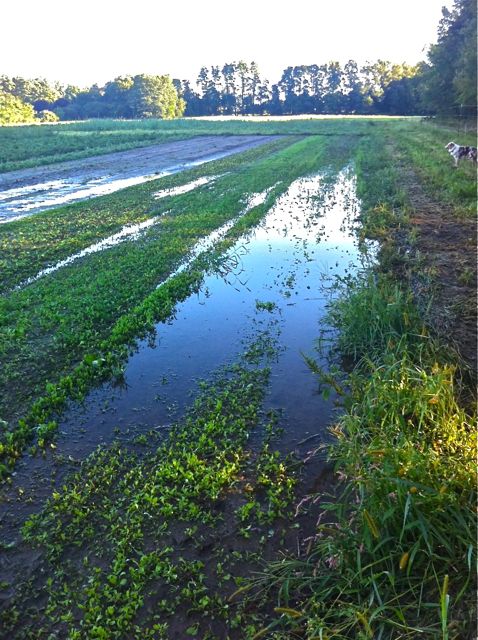 A flooded Vermont corn field.Photo: putneypicsWith flood waters receding and the Irene clean-up well underway, now’s the time to check in on how farmers fared in the face of this monster storm. The answer is: pretty bad. But it could have been even worse.
A flooded Vermont corn field.Photo: putneypicsWith flood waters receding and the Irene clean-up well underway, now’s the time to check in on how farmers fared in the face of this monster storm. The answer is: pretty bad. But it could have been even worse.
The produce trade paper The Packer spoke to agriculture officials in various states. According to New Jersey’s assistant secretary of agriculture, damage was “sporadic,” but will likely still cause some supply problems. Some newly planted crops were washed away and flood waters caused damage to crops on the vine, but there will still be enough time in the season to replant most crops, so severe shortages shouldn’t occur.
Farther south, the damage was more severe. And yet, as one Virginia farmer said, “it wasn’t as bad as it could have been.” The storm made its initial landfall on North Carolina; farmers there were hardest hit. The president of a produce sales group told The Packer, “From general assessment, on the North Carolina farms, I don’t know if there will be anything left.” That said, others put the losses in North Carolina from 10-40 percent of the normal yield, depending on the crop.
Massachusetts farmers saw the lightest damage. According to this report from Worcester, Mass., the sweet corn crop was most affected but might still be salvageable. The photo they ran with the article shows corn stalks virtually flattened by wind and rain; time is of the essence as farmers rush to get the mature corn off the ground in time. Apples were another near miss — had the storm hit a few weeks from now, the wind would have knocked ripe fruit off the trees. As it is, all but 5 percent of the fruit appears to have stayed put.
In the end, it might have been the New York and Vermont growers who took the brunt of the storm. The New York Times painted a picture of devastation for upstate New York farms:
From the Hudson Valley to areas farther north, along the Mohawk River and Schoharie Creek, New York growers, many of whose farms have been in the family for generations, were dealt a devastating blow by the storm, which dumped heavy rain on the region. Some farmers, who were without power and hobbled by disabled equipment, were not even able to assess the full extent of the damage.
State and local officials said the storm destroyed dozens of farms and crippled many others by killing livestock, submerging crops, washing away barns and buckling nearby roads. The onslaught came at the worst possible time, with farmers in the midst of harvesting a year’s worth of labor. In some spots, orange orbs were eerily visible underwater during flyovers by state officials — a vestige of the season’s pumpkin crop.
As for how this affects consumers, WNYC received this daunting assessment from Michael Hurwitz, director of the group that runs many of New York City’s farmers markets:
This could not have happened at a worse time of year… It’s a triple whammy. This is the busiest time of year at market. This is when the bulk of harvest is in. The fall is when our farmers earn their yearly income. It’s also a time of year when you can’t really replant what was lost. And it’s a time of year where you’re harvesting products that are going to sustain your business through the winter – those storage crops.
 Readers and organic farmers David and Melinda Rowley sent in this image of their flooded field in New York.Photo: Monkshood NurseryHurwitz estimated that 80 percent of NYC farmers market participants experienced damage, and, for as many as a third of those, the damage was exceptional.
Readers and organic farmers David and Melinda Rowley sent in this image of their flooded field in New York.Photo: Monkshood NurseryHurwitz estimated that 80 percent of NYC farmers market participants experienced damage, and, for as many as a third of those, the damage was exceptional.
New York Gov. Andrew Cuomo estimated agricultural losses in the state at $45 million (with the total cost to the state as high as a billion), but with flooding still a problem upstate, the full extent of the damage is yet to be determined.
The same is true in Vermont, where, as this local report indicates, so many towns are still cut off that there’s no clear sense of how extreme the losses may be.
And many of these farmers in the hardest hit areas of the Northeast are working without a net. The enormous and heavily subsidized federal crop insurance system is really built to protect large growers, particularly those who grow commodity crops like corn, soy, and cotton. Coverage for so-called “specialty crops” like fruits and vegetables exists but is complex, prohibitively expensive for small farmers, restricted to certain areas of the country and, with the possible exception of apples, not even available to most farmers in the Northeast. These farmers will be forced to rely on whatever federal disaster relief is made available to farmers, support that may yet get caught in more Republican budgetary intransigence.
How did Grist readers who farm weather the storm? From backyard growers to full-time farmers, we want to hear about it.



